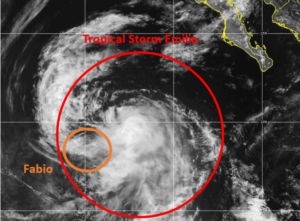Tropical Storm Maria brought wind and rain to northern Honshu on Sunday night. At 11:00 p.m. EDT on Sunday the center of Tropical Storm Maria was located at latitude 39.4°N and longitude 141.2°E which put the center about 10 miles (15 km) east of Hanamaki, Japan. Maria was moving toward the northwest at 14 m.p.h. (22 km/h). The maximum sustained wind speed was 60 m.p.h. (95 km/h) and there were wind gusts to 75 m.p.h. (120 km/h). The minimum surface pressure was 984 mb.
Tropical Storm Maria brought wind and rain to northern Honshu on Sunday night. The center of Maria’s circulation made landfall near Kesennuma in Miyagi prefecture. Tropical Storm Maria exhibited more organization as it neared landfall in northern Honshu. A small circular eye appeared on both satellite images and radar images from the Japan Meteorological Agency. The eye was surrounded by a ring of thunderstorms and the strongest winds were occurring in that ring of storms. Bands of thunderstorms were revolving around the center of Maria’s circulation.
The circulation around Tropical Storm Maria was fairly symmetrical at the time of landfall. Winds to tropical storm force extended out 120 miles (195 km) from the center of Maria’s circulation.
Tropical Storm Maria will move around the western end of a high pressure system over the North Pacific Ocean. The high pressure system will steer Maria toward the northwest during the next 24 hours. On its anticipated track, Tropical Storm Maria will move over Iwate and Akita prefectures. Maria could move over the Sea of Japan in 12 hours.
Tropical Storm Maria will weaken steadily as it moves across northern Honshu. Maria will continue to bring gusty winds and locally heavy rain to parts of Iwate and Akita prefectures during the next 12 to 24 hours. Heavy rain could cause flash floods in some locations.

